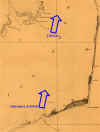The Yankees are Coming!
On February 5th Burnsides armada of troop transports, supply ships and gunboats get underway and sail north-east up Pamlico Sound towards Roanoke Island. Meeting no resistance, the head of the fleet reaches Stumpy Point late in the afternoon and stops for the night.
Early the next day, the ships weigh anchor and steam for Roanoke Island. A thick fog rolls in shortly thereafter and Admiral Goldsborough calls a halt to the advance.
Maps showing the route of Burnsides Expedition to Roanoke Island from Hatteras Inlet.
Please click on thumbs for larger version
The Confederates on Roanoke Island are making last minute preparations for the attack when the van of the Federal fleet is spotted south of the island. General Wise, still confined to bed in Nags Head issues orders to Colonel Shaw for the disposition of his troops for the defense of the island. Late in the afternoon on February 6th Shaw moves his troops to the probable troop landing areas. The garrison has three field pieces. A 24 pound howitzer, 18 pound Mexican war piece and a light 6 pound field gun. The artillery are to be divided between the two likely landing sites at Pugh's and Ashby's located south of Fort Bartow on the islands west side. One third of the infantry will be posted at Pugh's, the other at Ashby's and the remaining third at the earthwork at Suple's Hill. The infantry are ordered to contest any landing. If the troops at the landings are out flanked then they are to retreat to the earthwork. If that is flanked than they should get off the island and go to Nags Head.
The forts are manned by infantry men trained in servicing the 32 pound seacoast cannon mounted in them. (Fort's Bartow and Huger also mount one rifled gun a piece)
Commodore Lynch and his "Mosquito Fleet" of eight vessels are anchored on the north side of the Croatan Sound channel obstructions. The fleet is made up of the following: Steam tugs: Curlew, Ellis, Sea Bird, Beaufort, Raleigh, Fanny, Forrest Schooner: Black Warrior (anchored out of the action)
It takes until 9:00 A.M. on Friday February 7th for the fog to lift around the Federal fleet still anchored at Stumpy Point.
Goldsborough orders his ships to weigh anchor and proceed in three columns through the "Marshes". They meet no opposition and by 10:30 the advancing fleet can see Rebel ships on the north side of the channel obstructions. By 11:30 the gun boats and floating batteries are in position to commence firing on Ft. Bartow.
As the Union ships commence their bombardment of Ft. Bartow the infantry on both sides become spectators.
A few of the Federal warships fire on the "Mosquito Fleet" as the rest of the gunboats concentrate on Ft. Bartow.
The gunners in the fort give a good account of themselves despite being out gunned nine cannon to forty.
Only the left flank embrasure in Fort Bartow can bring guns to bear on any Federal ships.
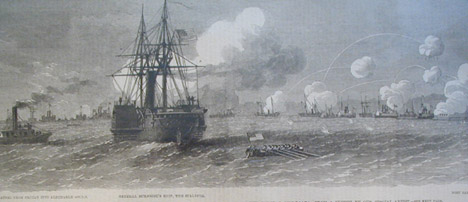
Federal warships bombard Ft. Bartow
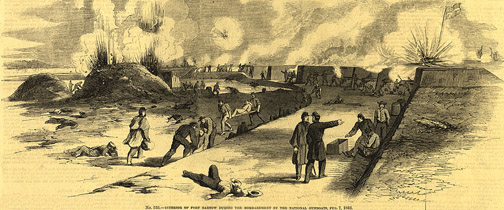
Interior of Fort Bartow during the shelling.
The Federal ships shell Fort Bartow through the early afternoon.
The men in the fort stand by their cannon despite the heavy bombardment. Union ships are struck by Confederate shells a total of twenty one times, inflicting fourteen casualties, three of which are fatal.
The flagstaff is shot down in Fort Bartow but the flag is quickly re-hoisted.
About three o'clock the barracks behind the fort are set on fire by the shelling. About the same time Federal sailors notice that the cannon fire from the fort has slackened.
Commodore Lynch's "Mosquito Fleet" is ineffective during the day. His nine ships stay behind the channel obstructions. When they venture close to Fort Bartow in order to draw attention away from the beleaguered earthwork the Forrest is struck in the propeller and disabled.
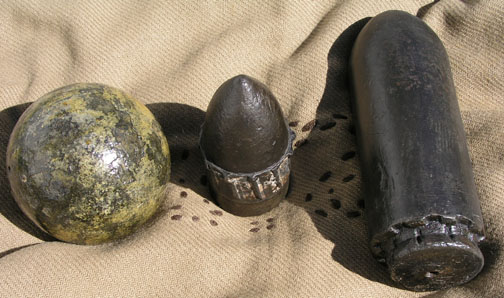
An assortment of artillery projectiles were fired from the Federal fleet during the bombardment of Fort Bartow. Solid 32#, Hotchkiss 3.4, 30# Parrot
A Union scouting party comprised of a lieutenant and a squad of infantry men, along with an escaped Negro boy who knows the Roanoke Island area set out in a row boat to find a suitable place for an amphibious landing for the army troops. As the boat nears the shore of Ashby's Harbor Confederates hiding several hundred yards north in the tall marsh grass attempt to capture the party, but are unsuccessful when some of the Rebels start to holler on the run thus alerting the Federals. Shots are exchanged and one Union soldier is slightly wounded. The men return to the fleet and report that Ashby's Harbor will be a suitable place to effect a landing.
As the troops of Foster's brigade are towed towards shore General Foster spies the gleam of bayonets in the woods behind the selected landing area. Foster orders the steamer north towards the Hammond House on the North side of Ashby's Harbor. The gunboats Delaware and Picket move in to shell the woods where the bayonets were seen.
The Confederates who were to contest the landing of Union troops on the island retreat to the earthwork at Suple's hill and await the impending battle.
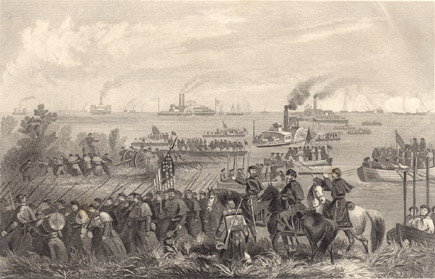
Infantry debark into row boats, surf boats and lighters which in turn are towed in groups towards shore by light draft steam boats. Running at full throttle, the steamers head towards shore until grounding, then the troops are cast off. The momentum sends the men even closer to shore until they run aground. Once aground the infantry get out in knee deep water and wade the rest of the way to dry land.
Commodore Lynch notes the landing in progress and orders his fleet to contest it. When several of his ships sail south the Curlew is promptly struck by a shell that hits her deck and passes through the bottom. The captain grounds his ship in front of Fort Forrest as Lynch withdraws north of the channel obstructions.
In a matter of several hours the majority of Burnsides infantry make landfall on Roanoke Island and encamp around the Hammond House.
Pickets are sent out to guard the Federal bivouac. When the 21st Massachusetts takes their turn at picket duty during the evening one man is wounded in a brief exchange of gunfire with rebels skirmishers.
The Yankee soldiers, already wet from wading ashore become even more miserable as rain starts to fall sometime before midnight. Fires do little to comfort the men who are already anxious from spending the night on enemy territory.
The Federals spend a restless night at Hammond House knowing full well that an impeding battle awaits them in the morrow.
The Confederates await the next day at Suple's Hill having been re-enforced by two companies of the 46th Virginia and eight companies of the 59th Virginia. These reinforcements are part of General Wise's Legion.
The "Mosquito Fleet" has been ineffective during the days fight. One ship has been sunk and another disabled.
Commodore Lynch meets with his boat captains and decides to retire his squadron to Elizabeth City to re-supply his ammunition. Later that night Lynch's fleet encounter a small convoy steaming towards Roanoke Island. The convoy is Confederate re-enforcements en-route to Roanoke Island. Two of the ships collide and two narrowly miss each other.
